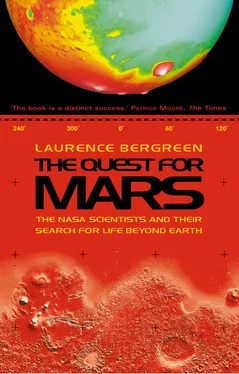George Bush’s remarks evoked John Kennedy’s famous speech in which he charged NASA with the duty of sending men to the moon. Without realizing it, Bush tapped into the agency’s other obsession, reaching Mars, an obsession that had begun in the mind of its ace rocket engineer, Wernher von Braun, during World War II. Von Braun, a member of the Nazi party, and a favorite of Hitler’s, had helped to design the V-2 missile. When he became disillusioned with the Nazi war machine, the Gestapo arrested him and sent him to jail. In his cell, he turned his attention to interplanetary travel, and Mars in particular. And it was in these strange and harsh circumstances that the kernel of what would become the American effort to explore Mars was born. In May 1945, von Braun and over a hundred other German rocket scientists surrendered to the Allies. They were swiftly transplanted to New Mexico to continue their work on rockets, this time for the United States. The German V-2 became the prototype of a new generation of American missiles, and on the strength of his engineering accomplishments for the Nazis, von Braun quickly established himself as the chief architect of the American space program’s booster rockets during the 1950s and 1960s; his designs were responsible for getting American men to the moon.
Throughout his career, von Braun was mesmerized by Mars. He published his plan to send people to Mars, the one he had conceived in jail, as a long magazine article titled “ Das Marsprojekt ,” which was translated into English. In 1953, it appeared as a book in the United States: The Mars Project . It became a classic, but this was not science fiction; The Mars Project contained no inspiring rhetoric about humankind’s greatest adventure. It was a how-to manual, a master plan for getting people to Mars. He used a simple slide rule to make his calculations, and its pages contained his blueprint for the actual mission, using available technology. “The logistic requirements for a large elaborate expedition to Mars are no greater than for those for a minor military operation extending over a limited theater of war,” he wrote. The key to reaching Mars, he believed, was sending a flotilla of spacecraft. “I believe it is time to explode once and for all the theory of the solitary space rocket and its little band of bold interplanetary travelers. No such lonesome, extra-orbital thermos bottle will ever escape Earth’s gravity and drift toward Mars.” Instead, in von Braun’s vision, “Each ship of the flotilla will be assembled in a two-hour orbital path around the earth, to which three-stage ferry rockets will deliver all the necessary components. Once the vessels are assembled, fueled, and ‘in all respects ready for space,’ they will leave this ‘orbit of departure’ and begin a voyage which will take them out of the earth’s field of gravity and set them into an elliptical orbit around the sun … Three of the vessels will be equipped with ‘landing boats’ for descent to Mars’s surface. Of these three boats, two will return to the circum-Martian orbit after shedding the wings which enabled them to use the Martian atmosphere for a glider landing. The landing party will be trans-shipped to the seven interplanetary vessels, together with the crews of the three which bore the landing boats and whatever Martian materials have been gathered. The two boats and the three ships which bore them will be abandoned in the circum-Martian orbit, and the entire personnel will return to Earth orbit in the seven remaining planetary ships. From this orbit, the men will return to the earth’s surface by the upper stages of the same three-stage ferry vessels which served to build and equip the space ships.” It was a grand scheme, and it became the template for NASA’s plans to send people to Mars, a goal von Braun thought could be accomplished by the late 1970s.
Bush’s speech endowed von Braun’s dormant plan with new life, but the prospect of returning to Mars raised new questions, as well. If NASA planned to send people to Mars safely, scientists needed to know much more about the Red Planet. If there was life on Mars, what form did it take? Was it dangerous to humans? Could it devastate the Earth if astronauts brought samples home? How severe were the effects of radiation? And, most important, was there water on Mars? The presence of water would dramatically enhance the prospects for finding life, but more than that, water meant it would be possible to manufacture rocket fuel, oxygen, and other human essentials on Mars.
Three years after Bush’s speech, in 1992, NASA announced plans to send between twelve and twenty small landers to Mars. They would fly frequently, and they would take advantage of new equipment, especially computer technology, to explore more effectively. The new program went by the name of Mars Environmental Survey – MESUR, in NASA-speak. The agency then announced another planetary program, Discovery, with similar goals; it was a nice instance of the right hand not knowing what the left was doing. Eventually, the two programs merged into one trial program: Pathfinder. It was going to be fast, it was going to be cheap, but no one knew if it would be better than previous planetary missions. Unlike most NASA missions, which are built and often operated by a private aerospace contractor such as Lockheed Martin, Pathfinder was an in-house project, designed, built, and operated by JPL. It was meant to embody JPL’s prowess as NASA’s robotics center, and that posed an embarrassing problem.
It had been a generation since Americans had landed a spacecraft on Mars. The old guard was gone, and few around JPL or NASA remembered exactly how that trick worked. Some scientific data had been preserved, though not completely, along with thousands of Viking images, but there was little documentation of the mission’s engineering accomplishments. Rob Manning, the young leader of Pathfinder’s Entry, Descent, and Landing team, sought veterans who could tell him what they had done on Viking, but many had died, and others had retired. JPL pulled a few of the old grizzlies out of retirement to help assemble a unit capable of developing a lander, and they went to work under Manning.
The idea behind Pathfinder, to develop and build a new spacecraft on a drastically reduced schedule and budget to land on the surface of Mars, sounded like a losing proposition to many at JPL, given the risks involved in getting there. Just setting their ship safely onto the surface posed difficult engineering problems. The spacecraft travels at about 17,000 miles an hour as it reaches Mars. Then it must slow to nearly zero miles an hour so that it does not vaporize in the Martian atmosphere or crash into the surface like a meteorite. The Viking solution to this problem, an expensive and cumbersome one, employed powerful, heavy thrusters capable of guiding the spacecraft gently to the surface. There was no money for that kind of extravagance with Pathfinder. Instead, Pathfinder’s engineers planned to wrap the lander in a protective bubble, place the bubble inside an aerodynamic cone, and parachute it through Mars’ thin atmosphere to the surface, letting the cone peel off in sections. Then Pathfinder would bounce around the surface like a big hi-tech beach ball. If all these cushioning devices worked properly, Pathfinder would still be in once piece when it came to a stop. This follow-the-bouncing spacecraft approach was profoundly troubling to conservative NASA engineers, but Manning casually accepted the risks. “Pathfinder is just a rotating bullet with nothing controlling it. This cone shape produces some unstable results – not so unstable that it’s devastating, but you live with that.” When he presented his landing scheme to NASA’s review board, they were, he said, “skeptical – borderline hostile, as they should be. They were paid to challenge everything. So it was a big deal when we deviated from the Viking heritage.”
Читать дальше












